Barbary pirates
The Barbary pirates, sometimes called Barbary corsairs or Ottoman corsairs, were Muslim pirates and privateers who operated from North Africa, based primarily in the ports of Salé, Rabat, Algiers, Tunis, and Tripoli. This area was known in Europe as the Barbary Coast, a term in reference to Greco-Roman ''barbarian'' used by emerging Europeans powers to denote parts of Northern Africa plagued by constant Muslim pirates and privateers, who according to European standards at that time were far from the realm of civilization.[1]. Their predation extended throughout the Mediterranean, south along West Africa's Atlantic seaboard and into the North Atlantic as far north as Iceland, but they primarily operated in the western Mediterranean. In addition to seizing merchant ships, they engaged in Razzias, raids on European coastal towns and villages, mainly in Italy, France, Spain, and Portugal, but also in the British Isles,[2] the Netherlands, and Iceland.[3] The main purpose of their attacks was slaves for the Ottoman slave trade as well as the general Arab slavery market in North Africa and the Middle East. Slaves in Barbary could be of many ethnicities, and of many different religions, such as Christian, Jewish, or Muslim.[2]

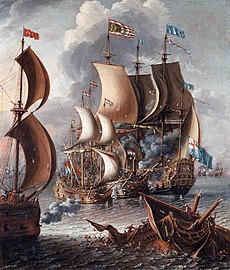
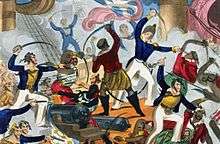


While such raids had occurred since soon after the Muslim conquest of Iberian Peninsula in the 710s, the terms "Barbary pirates" and "Barbary corsairs" are normally applied to the raiders active from the 16th century onwards, when the frequency and range of the slavers' attacks increased. In that period Algiers, Tunis and Tripoli came under the sovereignty of the Ottoman Empire, either as directly administered provinces or as autonomous dependencies known as the Barbary States. Similar raids were undertaken from Salé and other ports in Morocco.
Barbary corsairs captured thousands of merchant ships and repeatedly raided coastal towns. As a result, residents abandoned their former villages of long stretches of coast in Spain and Italy. Between 100,000 and 250,000 Iberians were enslaved by these raids.
The raids were such a problem coastal settlements were seldom undertaken until the 19th century. Between 1580 and 1680 corsairs were said to have captured about 850,000 people as slaves and from 1530 to 1780 as many as 1,250,000 people were enslaved.[2] However, these numbers have been questioned by the historian David Earle.[4] Some of these corsairs were European outcasts and converts (renegade) such as John Ward and Zymen Danseker.[3] Hayreddin Barbarossa and Oruç Reis, Turkish Barbarossa Brothers, who took control of Algiers on behalf of the Ottomans in the early 16th century, were also notorious corsairs. The European pirates brought advanced sailing and shipbuilding techniques to the Barbary Coast around 1600, which enabled the corsairs to extend their activities into the Atlantic Ocean.[3] The effects of the Barbary raids peaked in the early to mid-17th century.
Long after Europeans had abandoned oar-driven vessels in favor of sailing ships carrying tons of powerful cannon, many Barbary warships were galleys carrying a hundred or more fighting men armed with cutlasses and small arms. The Barbary navies were not battle fleets. When they sighted a European frigate, they fled.[5]
The scope of corsair activity began to diminish in the latter part of the 17th century,[6] as the more powerful European navies started to compel the Barbary States to make peace and cease attacking their shipping. However, the ships and coasts of Christian states without such effective protection continued to suffer until the early 19th century. Following the Napoleonic Wars and the Congress of Vienna in 1814–15, European powers agreed upon the need to suppress the Barbary corsairs entirely and the threat was largely subdued. Occasional incidents occurred, including two Barbary wars between the United States and the Barbary States, until finally terminated by the French conquest of Algeria in 1830.
History
In 1198 the problem of Barbary piracy and slave-taking was so great that the Trinitarians, a religious order, were founded to collect ransoms and even to exchange themselves as ransom for those captured and pressed into slavery in North Africa. In the 14th century Tunisian corsairs became enough of a threat to provoke a Franco-Genoese attack on Mahdia in 1390, also known as the "Barbary Crusade". Morisco exiles of the Reconquista and Maghreb pirates added to the numbers, but it was not until the expansion of the Ottoman Empire and the arrival of the privateer and admiral Kemal Reis in 1487 that the Barbary corsairs became a true menace to shipping from European Christian nations.[7]

During the American Revolution the pirates attacked American merchant vessels in the Mediterranean. But, on December 20, 1777, Sultan Mohammed III of Morocco issued a declaration recognizing America as an independent country, and that American merchant ships could enjoy safe passage into the Mediterranean and along the coast.[8][9] The relations were formalized with the Moroccan-American Treaty of Friendship signed in 1786, which stands as the U.S.'s oldest non-broken friendship treaty[10][11] with a foreign power.
As late as 1798, an islet near Sardinia was attacked by the Tunisians, and more than 900 inhabitants were taken away as slaves.[12]
16th century
.jpg)
From 1659, these African cities, although nominally part of the Ottoman Empire, were in fact military republics that chose their own rulers and lived by war booty captured from the Spanish and Portuguese. There are several cases of Sephardic Jews, including Sinan Reis and Samuel Pallache, who upon fleeing Iberia turned to attacking the Spanish Empire's shipping under the Ottoman flag, a profitable strategy of revenge for the Inquisition's religious persecution.[13][14]
During the first period (1518–1587), the beylerbeys were admirals of the sultan, commanding great fleets and conducting war operations for political ends. They were slave-hunters and their methods were ferocious. After 1587, the sole object of their successors became plunder, on land and sea. The maritime operations were conducted by the captains, or reises, who formed a class or even a corporation. Cruisers were fitted out by investors and commanded by the reises. Ten percent of the value of the prizes was paid to the pasha or his successors, who bore the titles of agha or dey or bey.[15]
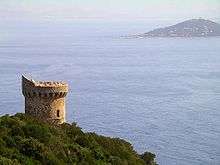
In 1544 Hayreddin captured the island of Ischia, taking 4,000 prisoners, and enslaved some 2,000–7,000 inhabitants of Lipari.[16][17] In 1551 Turgut Reis enslaved the entire population of the Maltese island of Gozo, between 5,000 and 6,000, sending them to Ottoman Tripolitania. In 1554 corsairs under Turgut Reis sacked Vieste, beheaded 5,000 of its inhabitants, and abducted another 6,000.[18]
17th century
_by_Aert_Anthoniszoon.jpg)
A notable counter action occurred in 1607, when the Knights of Saint Stephen (under Jacopo Inghirami) sacked Bona in Algeria, killing 470 and taking 1,464 captives.[19] This victory is commemorated by a series of frescoes painted by Bernardino Poccetti in the "Sala di Bona" of Palazzo Pitti, Florence.[20][21] In 1611 Spanish galleys from Naples, accompanied by the galleys of the Knights of Malta, raided the Kerkennah Islands off the coast of Tunisia and took away almost 500 Muslim captives.[22] Between 1568 and 1634 the Knights of Saint Stephen may have captured about 14,000 Muslims, with perhaps one-third taken in land raids and two-thirds taken on captured ships.[22]


Ireland was subject to a similar attack. In June 1631 Murat Reis, with corsairs from Algiers and armed troops of the Ottoman Empire, stormed ashore at the little harbor village of Baltimore, County Cork. They captured almost all the villagers and took them away to a life of slavery in North Africa.[15] The prisoners were destined for a variety of fates – some lived out their days chained to the oars as galley slaves, while women spent long years as concubines in harems or within the walls of the sultan's palace. Only two of these captives ever returned to Ireland.[23]
More than 20,000 captives were said to be imprisoned in Algiers alone. The rich were often able to secure release through ransom, but the poor were condemned to slavery. Their masters would on occasion allow them to secure freedom by professing Islam. A long list might be given of people of good social position, not only Italians or Spaniards, but German or English travelers in the south, who were captives for a time.[15]


In 1675 a Royal Navy squadron led by Sir John Narborough negotiated a lasting peace with Tunis and, after bombarding the city to induce compliance, with Tripoli.[24]
18th–19th centuries
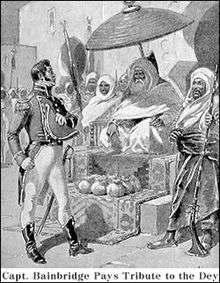
Piracy was enough of a problem that some states entered into the redemption business. In Denmark, "At the beginning of the 18th century money was collected systematically in all churches, and a so called 'slave fund' (slavekasse) was established by the state in 1715. Funds were brought in through a compulsory insurance sum for seafarers. 165 slaves were ransomed by this institution between 1716 and 1736."[25] "Between 1716 and 1754 19 ships from Denmark-Norway were captured with 208 men; piracy was thus a serious problem for the Danish merchant fleet."[25]
Until the American Declaration of Independence in 1776, British treaties with the North African states protected American ships from the Barbary corsairs. Morocco, which in 1777 was the first independent nation to publicly recognize the United States, in 1784 became the first Barbary power to seize an American vessel after the nation achieved independence. The Barbary threat led directly to the United States founding the United States Navy in March 1794. While the United States did secure peace treaties with the Barbary states, it was obliged to pay tribute for protection from attack. The burden was substantial: in 1800 payments in ransom and tribute to the Barbary states amounted to 20% of United States federal government's annual expenditures.[26]
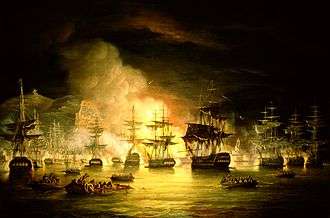
The Barbary states had difficulty securing uniform compliance with a total prohibition of slave-raiding, as this had been traditionally of central importance to the North African economy. Slavers continued to take captives by preying on less well-protected peoples. Algiers subsequently renewed its slave-raiding, though on a smaller scale. Europeans at the Congress of Aix-la-Chapelle in 1818 discussed possible retaliation. In 1824 a British fleet under Admiral Sir Harry Neal bombarded Algiers. Corsair activity based in Algiers did not entirely cease until France conquered the state in 1830.[15]
Slaves
Barbary slaves
According to Robert Davis, between 1 million and 1.25 million Europeans were captured by Barbary pirates and sold as slaves in North Africa and Ottoman Empire between the 16th and 19th centuries.[27][28] However, to extrapolate his numbers, Davis assumes the number of European slaves captured by Barbary pirates were constant for a 250-year period, stating:
There are no records of how many men, women and children were enslaved, but it is possible to calculate roughly the number of fresh captives that would have been needed to keep populations steady and replace those slaves who died, escaped, were ransomed, or converted to Islam. On this basis it is thought that around 8,500 new slaves were needed annually to replenish numbers – about 850,000 captives over the century from 1580 to 1680. By extension, for the 250 years between 1530 and 1780, the figure could easily have been as high as 1,250,000.[4]

Davis' numbers have been questioned by the historian David Earle, who said of Davis' numbers "His figures sound a bit dodgy and I think he may be exaggerating" and cautioned that the true picture of European slaves is clouded by the fact that the corsairs also seized non-Christian whites from eastern Europe and black people from west Africa.[4]
In addition, the number of slaves traded was hyperactive, with exaggerated estimates relying on peak years to calculate averages for entire centuries, or millennia. Hence, there were wide fluctuations year-to-year, particularly in the 18th and 19th centuries, given slave imports, and given the fact that, prior to the 1840s, there are no consistent records. Middle East expert, John Wright, cautions that modern estimates are based on back-calculations from human observation.[29]
Such observations, across the late 1500s and early 1600s observers, account for around 35,000 European Christian slaves held throughout this period on the Barbary Coast, across Tripoli, Tunis, but mostly in Algiers. The majority were sailors (particularly those who were English), taken with their ships, but others were fishermen and poor coastal villagers. However, most of these captives were people from lands close to Africa, particularly Spain and Italy.[30]
From bases on the Barbary coast, North Africa, the Barbary pirates raided ships traveling through the Mediterranean and along the northern and western coasts of Africa, plundering their cargo and enslaving the people they captured. From at least 1500, the pirates also conducted raids along seaside towns of Italy, France, Spain, Portugal, England, the Netherlands and as far away as Iceland, capturing men, women and children. On some occasions, settlements such as Baltimore, Ireland were abandoned following the raid, only being resettled many years later. Between 1609 and 1616, England alone had 466 merchant ships lost to Barbary pirates.[31]

Captives often suffered from privation on voyages to North Africa if taken at a distance. Those who survived the journeys were often forced to walk through town as they were taken to slave auctions. The slaves typically had to stand from eight in the morning until two in the afternoon while buyers viewed them. Next came the auction, where the townspeople would bid on the captives they wanted to purchase and once that was over, the governor of Algiers (the Dey) had the chance to purchase any slave he wanted for the price they were sold at the auction. During the auctions the slaves would be forced to run and jump around to show their strength and stamina. After purchase, the captives would either be held for ransom, or be put to work. Slaves were used for a wide variety of jobs, from hard manual labor to housework (the job assigned to most women slaves). At night the slaves were put into prisons called 'bagnios' (derived from the Italian word "bagno" for public bath, inspired by the Turks' use of Roman baths at Constantinople as prisons),[32] which were often hot and overcrowded. However, these bagnios began improving by the 18th century. Some bagnios had chapels, hospitals, shops, and bars run by captives, though such amenities remained uncommon.
Galley slaves

Although the conditions in bagnios were harsh, they were better than those endured by galley slaves. Most Barbary galleys were at sea for around eighty to a hundred days a year, but when the slaves assigned to them were on land, they were forced to do hard manual labor. There were exceptions: "galley slaves of the Ottoman Sultan in Constantinople would be permanently confined to their galleys, and often served extremely long terms, averaging around nineteen years in the late seventeenth-century and early eighteenth-century periods. These slaves rarely got off the galley but lived there for years."[33] During this time, rowers were shackled and chained where they sat, and never allowed to leave. Sleeping (which was limited), eating, defecation and urination took place at the seat to which they were shackled. There were usually five or six rowers on each oar. Overseers would walk back and forth and whip slaves considered not to be working hard enough.

Famous Barbary corsairs
According to historian Adrian Tinniswood, the most notorious corsairs were English and European renegades who had learned their trade as privateers, and who moved to the Barbary Coast during peacetime to pursue their trade. These outcasts brought up-to-date naval expertise to the piracy business, and enabled the corsairs to make long-distance slave-catching raids as far away as Iceland and Newfoundland.[3] The English corsair Henry Mainwaring later returned to England after gaining a royal pardon. He was knighted, elected to Parliament, and appointed a vice admiral of the Royal Navy.[3]
Barbarossa brothers
Oruç Barbarossa
The most famous of the corsairs in North Africa were Albanian/Greek[34][35] brothers Oruç and Hızır Hayreddin. They, and two less well-known brothers all became Barbary corsairs in the service of the Ottoman Empire; they were called the Barbarossas (Italian for Redbeards) after the red beard of Oruç, the eldest. Oruç captured the island of Djerba for the Ottoman Empire in 1502 or 1503. He often attacked Spanish territories on the coast of North Africa; during one failed attempt in 1512 he lost his left arm to a cannonball. The eldest Barbarossa also went on a rampage through Algiers in 1516, and captured the town with the help of the Ottoman Empire. He executed the ruler of Algiers and everybody he suspected would oppose him, including local rulers. He was finally captured and killed by the Spanish in 1518, and put on display.
Hızır Hayreddin Barbarossa

Oruç, based mainly on land, was not the best-known of the Barbarossas. His youngest brother Hızır (later called Hayreddin or Kheir ed-Din) was a more traditional corsair. He was a capable engineer and spoke at least six languages. He dyed the hair of his head and beard with henna to redden it like Oruç's. After capturing many crucial coastal areas, Hayreddin was appointed admiral-in-chief of the Ottoman sultan's fleet. Under his command the Ottoman Empire was able to gain and keep control of the Mediterranean for over thirty years. Barbaros Hızır Hayreddin Pasha died in 1546 of a fever, possibly the plague.
Captain Jack Ward
English corsair Jack, or John, Ward was once called "beyond doubt the greatest scoundrel that ever sailed from England" by the English ambassador to Venice. Ward was a privateer for Queen Elizabeth during her war with Spain; after the end of the war, he became a corsair. With some associates he captured a ship in about 1603 and sailed it to Tunis; he and his crew converted to Islam. He was successful and became rich. He introduced heavily armed square-rigged ships, used instead of galleys, to the North African area, a major reason for the Barbary's future dominance of the Mediterranean. He died of plague in 1622.
Sayyida al-Hurra
Sayyida al-Hurra was a female Muslim cleric, merchant, governor of Tétouan, and later the wife of the sultan of Morocco.[36][37] She was born around 1485 in the Emirate of Granada, but was forced to flee to Morocco when she was very young to escape the Reconquista. In Morocco, she gathered a crew largely of exiled Moors, and launched pirate expeditions against Spain and Portugal to avenge the Reconquista, protect Morocco from Christian pirates, and seek riches and glory. She co-founded the Barbary Corsairs with her allies the Barbarossa brothers. Sayyida al-Hurra became wealthy and renowned enough for the Sultan of Morocco, Ahmad al-Wattasi to make her his queen. Notably, however, she refused to marry in his capital of Fez, and would not get married but in Tétouan, of which she was governor. This was the first and only time in history that a Moroccan monarch had married away from his capital.
Other famous Barbary corsairs

- Kemal Reis (c. 1451–1511)
- Gedik Ahmed Pasha (died 1482)
- Sinan Reis (died 1546)
- Piri Reis (died 1554 or 1555)
- Turgut Reis (1485–1565)
- Sinan Pasha (died 1553)
- Kurtoğlu Muslihiddin Reis (1487–c. 1535)
- Kurtoğlu Hızır Reis
- Salih Reis (c. 1488–1568)
- Seydi Ali Reis (1498–1563)
- Piyale Pasha (c. 1515–1578)
- Raïs Hamidou (1773–1815)
- Uluç Ali Reis (1519–1587)
- Ali Bitchin (c. 1560–1645)
- Simon de Danser or Simon Reis (c. 1579–c. 1611)
- Ivan-Dirkie de Veenboer or Sulayman Reis (died 1620)
- Murat Reis the Elder (c. 1534–1638)
- Jan Janszoon or Murat Reis the Younger (c. 1570–after 1641)
In fiction
_-_Foto_Giovanni_Dall'Orto%2C_13-4-2006_12.jpg)
Barbary corsairs are protagonists in Le pantere di Algeri (the panthers of Algiers) by Emilio Salgari. They were featured in a number of other noted novels, including Robinson Crusoe by Daniel Defoe, The Count of Monte Cristo by Alexandre Dumas, père, The Wind in the Willows by Kenneth Grahame, The Sea Hawk and the Sword of Islam by Rafael Sabatini, The Algerine Captive by Royall Tyler, Master and Commander by Patrick O'Brian, the Baroque Cycle by Neal Stephenson, The Walking Drum by Louis Lamour, Doctor Dolittle by Hugh Lofting, Corsair by Clive Cussler and Angélique in Barbary by Anne Golon. Miguel de Cervantes, the Spanish author, was captive for five years as a slave in the bagnio of Algiers, and reflected his experience in some of his fictional (but not directly autobiographical) writings, including the Captive's tale in Don Quixote, his two plays set in Algiers, El Trato de Argel (The Treaty of Algiers) and Los Baños de Argel (The Baths of Algiers), and episodes in a number of other works. In Mozart's opera Die Entführung aus dem Serail (a Singspiel), two European ladies are discovered in a Turkish harem, presumably captured by Barbary corsairs. Rossini's opera L'Italiana in Algeri is based on the capture of several slaves by Barbary corsairs led by the bey of Algiers.
One of the stereotypical features of a pirate as portrayed in popular culture, the eye patch, may have been partially derived from the Arab corsair Rahmah ibn Jabir al-Jalahimah, who wore a patch after losing an eye in battle in the 18th century.[38]
See also
- Albanian piracy
- Anglo-Turkish piracy
- Barbary Slave Trade
- Barbary treaties
- Circassian beauties
- Ghazw
- Islamic views on slavery
- Imperial Harem
- List of Ottoman sieges and landings
- Morisco
- Ottoman–Habsburg wars
- Ottoman Navy
- Republic of Bou Regreg
- Romegas
- Slavery in the Ottoman Empire
- Turkish Abductions
- Morocco–United States relations
| Wikimedia Commons has media related to Barbary Corsairs. |
Notes
- Colás, Alejandro (February 2016). "Barbary Coast in the expansion of international society: Piracy, privateering, and corsairing as primary institutions". Review of International Studies. 42 (5): 840–857. doi:10.1017/S0260210516000152. ISSN 0260-2105.
- Robert Davis (2011-02-17). "British Slaves on the Barbary Coast". bbc.co.uk. Retrieved 27 March 2019.
- Review of Pirates of Barbary by Ian W. Toll, New York Times, 12 Dec. 2010
- Carroll, Rory; correspondent, Africa (2004-03-11). "New book reopens old arguments about slave raids on Europe". The Guardian. ISSN 0261-3077. Retrieved 2017-12-11.
- Conlin, Joseph R. The American Past: A Survey of American History, Volume I: To 1877. p. 206.
- Chaney, Eric (2015-10-01). "Measuring the military decline of the Western Islamic World: Evidence from Barbary ransoms". Explorations in Economic History. 58: 107–124. doi:10.1016/j.eeh.2015.03.002.
- Pryor (1988), p. 192
- Tucker, Spencer C. (2014-06-11). The Encyclopedia of the Wars of the Early American Republic, 1783–1812: A Political, Social, and Military History [3 volumes]: A Political, Social, and Military History. ISBN 9781598841572.
- Tucker, Spencer C. (2014-06-11). The Encyclopedia of the Wars of the Early American Republic, 1783–1812: A Political, Social, and Military History [3 volumes]: A Political, Social, and Military History. ISBN 9781598841572.
- Roberts, Priscilla H. and Richard S. Roberts, Thomas Barclay (1728–1793: Consul in France, Diplomat in Barbary, Lehigh University Press, 2008, pp. 206–223.
- "Milestones of American Diplomacy, Interesting Historical Notes, and Department of State History". U.S. Department of State. Retrieved 2007-12-17.
- Christian Slaves, Muslim Masters: White Slavery in the Mediterranean, the Barbary Coast and Italy, 1500–1800. Robert Davis (2004). p.45. ISBN 1-4039-4551-9.
- Kritzler, Edward (November 3, 2009). Jewish Pirates of the Caribbean. Anchor. pp. 59–60. ISBN 978-0-7679-1952-4. Retrieved 2010-05-02.
- Plaut, Steven (October 15, 2008). "Putting the Oy Back into 'Ahoy'". Retrieved 2010-04-27. Archived 2013-11-10 at the Wayback Machine
- Chisholm, Hugh, ed. (1911). . Encyclopædia Britannica (11th ed.). Cambridge University Press.
- Syed, Muzaffar Husain; Akhtar, Syed Saud; Usmani, B. D. (2011-09-14). Concise History of Islam. Vij Books India Pvt Ltd. ISBN 9789382573470.
- Her Majesty's Commission, State Papers (1849). King Henry the Eighth Volume 10 Part V Foreign Correspondence 1544-45. London.
- Mercati, Angelo (1982). Saggi di storia e letteratura, vol. II. Rome.
- John B. Hattendorf and Richard W. Unger (2003). War at Sea in the Middle Ages and the Renaissance. Boydell Press.
- "Curator's comments on a draft study by Bernardino Poccetti". The British Museum.
- "Palazzo Pitti".
- Jamieson, Alan (2012). Lords of the Sea: A History of the Barbary Corsairs. London.
- Ekin, Des (2006). The Stolen Village – Baltimore and the Barbary Pirates. OBrien. ISBN 978-0-86278-955-8.
- "Articles of peace & commerce between ... Charles II ... and the ... Lords the Bashaw, Dey, Aga, Divan, and governours of the ... kingdom of Tripoli concluded by Sir John Narbrough ... the first day of May, 1676". University of Michigan.
- Peter Madsen, "Danish slaves in Barbary", Islam in European Literature Conference, Denmark Archived November 10, 2014, at the Wayback Machine
- Oren, Michael B. (2005-11-03). "The Middle East and the Making of the United States, 1776 to 1815". Retrieved 2007-02-18.
- Davis, Robert. Christian Slaves, Muslim Masters: White Slavery in the Mediterranean, the Barbary Coast and Italy, 1500–1800.
- "When Europeans were slaves: Research suggests white slavery was much more common than previously believed" Archived 2011-07-25 at the Wayback Machine, Research News, Ohio State University
- Wright, John (2007). "Trans-Saharan Slave Trade". Routledge.
- Davis, Robert (17 Feb 2011). "British Slaves on the Barbary Coast". BBC.
- Rees Davies, "British Slaves on the Barbary Coast", BBC, 1 July 2003
- Definition of "bagnio" from the Free Merriam-Webster Dictionary. Accessed 23 February 2015
- Ekin, Des (2006). The Stolen Village – Baltimore and the Barbary Pirates. OBrien. p. 187. ISBN 978-0-86278-955-8.
- Between Venice and Istanbul : colonial landscapes in early modern Greece. Davies, Siriol., Davis, Jack L. [Princeton]: American School of Classical Studies at Athens. 2007. ISBN 9780876615409. OCLC 126229997.CS1 maint: others (link)
- Capponi, Niccolò. (2007). Victory of the West : the great Christian-Muslim clash at the Battle of Lepanto (1st Da Capo Press ed.). Cambridge, MA: Da Capo Press. ISBN 978-0306815447. OCLC 86222610.
- Mernissi, Fatima (July 30, 1997). The Forgotten Queens of Islam. Univ of Minnesota Press. pp. 18–19, 115, 193. ISBN 978-0-8166-2439-3.
- Park, Thomas Kerlin; Boum, Aomar (2006). Historical dictionary of Morocco. The Scarecrow Press, Inc. p. 317. ISBN 978-0-8108-5341-6.
- Charles Belgrave (1966), The Pirate Coast, p. 122, George Bell & Sons
References
- Clissold, Stephen. 1976. "Christian Renegades and Barbary Corsairs." History Today 26, no. 8: 508–515. Historical Abstracts.
- Davis, Robert C., Christian Slaves, Muslim Masters: White Slavery in the Mediterranean, The Barbary Coast, and Italy, 1500–1800. Palgrave Macmillan, New York. 2003. ISBN 0-333-71966-2
- Earle, Peter. The Pirate Wars. Thomas Dunne. 2003
- Forester, C. S. The Barbary Pirates. Random House. 1953
- Konstam, Angus A History of Pirates.
- Kristensen, Jens Riise, Barbary To and Fro Ørby Publishing. 2005.
- Leiner, Frederick C. The End of Barbary Terror: America's 1815 War against the Pirates of North Africa. Oxford University Press, Oxford. 2006
- Lambert, Frank. The Barbary Wars: American Independence in the Atlantic World. Hill & Wang, 2005JJos
- Lloyd, Christopher. 1979. "Captain John Ward: Pirate." History Today 29, no. 11; p. 751.
- Matar, Nabil. 2001. "The Barbary Corsairs, King Charles I and the Civil War." Seventeenth Century 16, no. 2; pp. 239–258.
- Pryor, John H., Geography, Technology, and WarStudies in the Maritime History of the Mediterranean, 649–1571. Cambridge University Press, Cambridge. 1988. ISBN 0-521-34424-7
- Severn, Derek. "The Bombardment of Algiers, 1816." History Today 28, no. 1 (1978); pp. 31–39.
- Silverstein, Paul A. 2005. "The New Barbarians: Piracy and Terrorism on the North African Frontier." CR: The New Centennial Review 5, no. 1; pp. 179–212.
- Travers, Tim, Pirates: A History. Tempus Publishing, Gloucestershire. 2007.
- World Navies
- To the Shores of Tripoli: The Birth of the U.S. Navy and Marines.—Annapolis, MD : Naval Institute Press, 1991, 2001.
Further reading
- Gawalt, Gerard W. "America and the Barbary pirates: An international battle against an unconventional foe." (Library of Congress, 2011) online.
- Sofka, James R. "The Jeffersonian idea of national security: commerce, the Atlantic balance of power, and the Barbary war, 1786–1805." Diplomatic History 21.4 (1997): 519-544. online
- Turner, Robert F. "President Thomas Jefferson and the Barbary Pirates." in Bruce A Elleman, et al. eds. Piracy and Maritime Crime: Historical and Modern Case Studies (2010): 157-172. online
- Adrian Tinniswood, Pirates of Barbary: Corsairs, Conquests and Captivity in the Seventeenth-Century Mediterranean, 343 pp. Riverhead Books, 2010. ISBN 978-1-59448-774-3. NY Times review
- White, Joshua M.Piracy and Law in the Ottoman Mediterranean (Stanford University Press, 2017). ISBN 978-1-50360-252-6.
- White Gold: The Extraordinary Story of Thomas Pellow and North Africa's One Million European Slaves by Giles Milton (Sceptre, 2005)
- London, Joshua E. Victory in Tripoli: How America's War with the Barbary Pirates Established the U.S. Navy and Shaped a Nation. New Jersey: John Wiley & Sons, Inc., 2005. ISBN 978-0-471-44415-2
- The pirate coast : Thomas Jefferson, the first marines and the secret mission of 1805 by Richard Zacks. Hyperion, 2005. ISBN 1-4013-0849-X
- Christian slaves, Muslim masters : white slavery in the Mediterranean, the Barbary Coast, and Italy, 1500–1800 by Robert C. Davis. New York : Palgrave Macmillan, 2003. ISBN 978-0-333-71966-4
- Piracy, Slavery and Redemption: Barbary Captivity Narratives from Early Modern England by D. J. Vikus (Columbia University Press, 2001)
- The Stolen Village: Baltimore and the Barbary Pirates by Des Ekin ISBN 978-0-86278-955-8
- Skeletons on the Zahara: A True Story of Survival by Dean King, ISBN 0-316-15935-2
- Oren, Michael. "Early American Encounters in the Middle East", in Power, Faith, and Fantasy. New York: Norton, 2007.
- Boot, Max (2002). The Savage Wars of Peace: Small Wars and the Rise of American Power. New York: Basic Books. ISBN 978-0-465-00720-2.
- Lambert, Frank. The Barbary Wars. New York: Hill and Wang, 2005.
- Whipple, A. B. C. To the Shores of Tripoli: The Birth of the U.S. Navy and Marines. Bluejacket Books, 1991. ISBN 1-55750-966-2
External links
- Hitchens, Christopher (Spring 2007). "Jefferson Versus the Muslim Pirates". City Journal. Retrieved 2007-04-28.
- Knights Hospitaller of St. John – Order of St John of Jerusalem Malta
- The Barbary Pirates
- New book reopens old arguments about slave raids on Europe
- Barbary Warfare
- The Barbary Wars at the Clements Library:An online exhibit on the Barbary Wars with images and transcriptions of primary documents from the period.
- American Barbary Wars
_2.svg.png)
